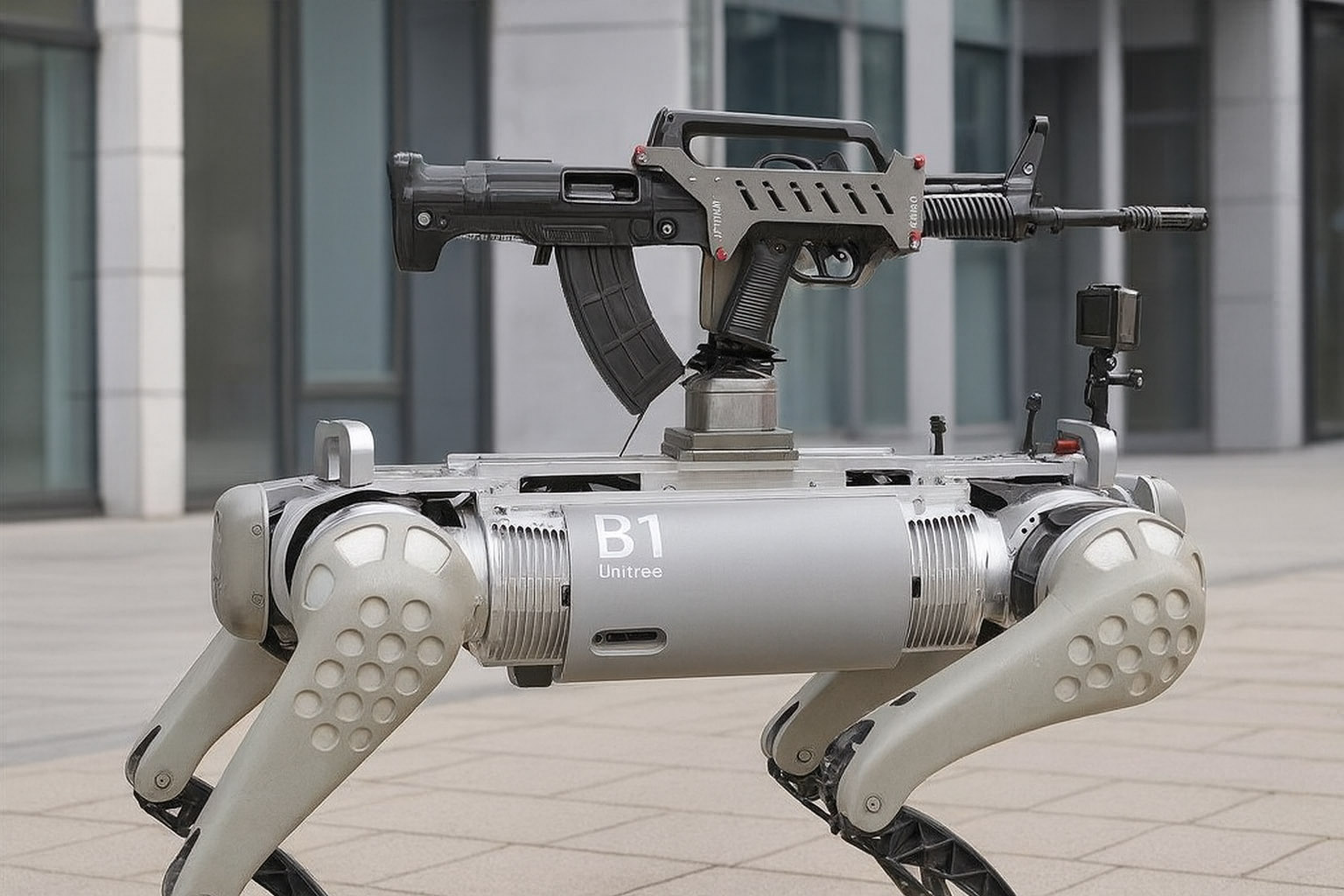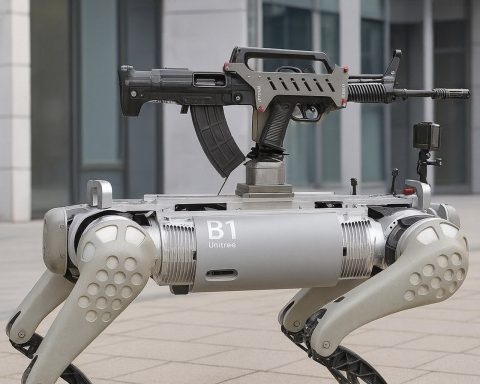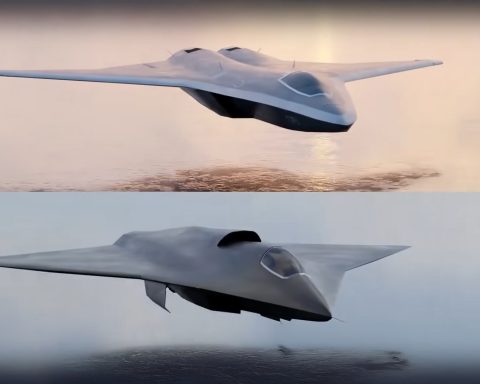- Field tests shown by state TV: China’s military channel (via People’s Daily Online) aired an exercise with the PLA’s 76th Group Army where four‑legged “robot wolves” maneuvered alongside infantry and FPV drones. en.people.cn
- Armed with standard PLA rifles: In the footage, several robots carried QBZ‑191 assault rifles—the PLA’s current‑generation 5.8×42 mm service weapon—while others mounted recon payloads. en.people.cn
- Weight and origin: The platform weighs about 70 kg (~154 lb) and was first unveiled at Airshow China 2024; it’s developed by state‑owned China South Industries Group Corp (CSGC). en.people.cn
- Pack tactics: PLA materials emphasize “coordinated formations” with humans, vehicles, and robot wolves sharing networks for recon, precision strikes, and cover during breakthroughs. en.people.cn
- Polish press framing: Poland’s Rzeczpospolita (via Money.pl) highlighted the tests and specified 70 kg weight and QBZ‑191 armament—terminology that popularized the “robo‑wolves” label. www.money.pl
- Public showings beyond the range: After Airshow China, the quadrupeds appeared in a September 2025 Beijing weapons parade coverage featuring four‑legged drones. The Guardian
- Mobility & control cues: Demonstrations have shown stair‑climbing, obstacle clearing, and even basic voice‑command following (“sit/stand/move”) on the Q‑UGV “Wolf” platform. The Times
- Likely “supervised autonomy,” not fully autonomous: PLA reporting describes human‑drone collaborative operations and operator networks—no official claim of fully autonomous, unsupervised lethal use. en.people.cn
- Performance caveats reported: Some coverage cites state‑media claims of limited range and battery endurance (e.g., ~2 km and a few hours), underscoring early‑stage constraints. The Times
- Global context: Armed quadrupeds are being trialed elsewhere too (e.g., US “robot dog” tests for counter‑drone roles), signalling a broader shift toward AI‑enabled ground systems. The War Zone
What exactly did China test?
In July 2025, the PLA’s 76th Group Army ran a confrontational drill integrating infantry, FPV drones and quadrupedal “robot wolves.” State TV footage (carried by People’s Daily Online) shows the robots moving with rifle‑armed soldiers, executing recon and providing covering fire during notional breakthroughs on hilly grassland terrain. The clip is notable for placing the robots inside a combined‑arms scenario, not just in a static display. en.people.cn
What are “robo‑wolves”?
China’s state media introduced the “robo‑wolf” (often identified as Q‑UGV Wolf) to the public at Airshow China 2024, describing a ~70 kg modular, four‑legged utility platform built by CSGC. According to those reports, it can climb stairs and high obstacles, keep pace with dismounted troops, and swap payloads for reconnaissance, attack, transport, or support roles. The July drill is the first publicized instance of these units training alongside frontline infantry. Global Times
Yes, they carried PLA rifles—specifically the QBZ‑191
The QBZ‑191 (5.8×42 mm) is the PLA’s standard modern assault rifle, replacing the older QBZ‑95 family. In the July exercise, PLA soldiers carried QBZ‑191 and QBU‑191 rifles—and several robot wolves were shown equipped with QBZ‑191s as payloads. That detail matters: it signals intent to treat the quadrupeds as small, mobile firing platforms compatible with infantry weapons and optics already in service. en.people.cn
How “autonomous” are they?
Chinese coverage consistently frames the trials as “human‑drone collaborative”, and mentions operators networking with robots and drones. Demonstrations at Zhuhai also showed robots following simple voice commands, but that does not imply independent target selection. At this stage, publicly shown employment suggests supervised autonomy (human‑in/‑on‑the‑loop) rather than fully autonomous lethal engagement. That aligns with broader international practice and debate around LAWS (lethal autonomous weapon systems). en.people.cn
Context: China’s own working paper to the UN CCW has favored negotiations on regulating certain autonomous weapons, while leaving room to develop AI‑enabled systems—an approach echoed by many states (positions vary on definitions and prohibitions). documents.unoda.org
What can they actually do today?
Mobility & teaming. The robots have been shown traversing uneven ground, climbing stairs/ladders, and moving in formation with infantry, while networked with FPV drones that scout or simulate strikes—classic “manned‑unmanned teaming.” Defense Mirror
Payloads. Configurations include rifles (the July drill used QBZ‑191s) and sensors for reconnaissance. In principle, the modular chassis could host other payloads (e.g., comms relays, EW sensors, light logistics packs). en.people.cn
Endurance/Range (unconfirmed in official specs). Some press, citing state media, has mentioned short ranges (on the order of ~2 km from a base) and battery life measured in hours, which would limit independent operations but still be useful for urban or complex‑terrain tasks near friendly units. Treat these as early performance hints, not final specs. The Times
Why the PLA cares: missions where legs beat wheels
Many militaries see a niche for legged platforms in places where wheeled/tracked robots struggle—rubble‑filled cities, steep slopes, stairs—precisely where reconnaissance and load‑carrying are risky for humans. The PLA’s own exercise narrative calls out urban, plateau, and mountainous environments and suggests pack behavior (division of roles among multiple robots) to extend coverage and persist under fire. en.people.cn
How we got here: from “robodogs” to “robowolves”
China previously showcased rifle‑toting robodogs during the Golden Dragon 2024 drills with Cambodia—clearly remote‑controlled and likely adapted from commercial platforms. The “robowolf” appears to be a heavier, more militarized Q‑UGV class with better mobility and payload capacity, introduced at Zhuhai 2024 and now appearing in PLA unit training—and even public parades. The Guardian
What about everyone else?
China isn’t alone. The US and others are experimenting with armed quadrupeds, including concepts to use them as counter‑drone shooters—an especially plausible role given the explosive growth of small UAS on modern battlefields. This is early‑stage across the board; militaries are probing what roles these machines perform well (and safely). The War Zone
Limitations and unanswered questions
- Accuracy & stabilization: Firing rifles from a small, moving quadruped stresses recoil management and stabilization. PLA footage confirms carriage and maneuver; sustained, accurate fire under combat conditions remains to be proven publicly. (State sources highlight capability but provide few technical details.) en.people.cn
- Power & payload tradeoffs: Battery technology limits the speed–range–payload triangle; heavier weapons reduce endurance. Reports of short range and hours‑long endurance reinforce that these are near‑unit assets for now. The Times
- Resilience: Leg actuators, sensors, and comms are vulnerable to mud, debris, gunfire, and EW. State media claims ruggedization and ladder‑climbing; independent durability data isn’t public. Global Times
- Human control: All publicly shown PLA employment implies human oversight; there’s no official claim of fully autonomous lethal targeting. That keeps deployments closer to current international norms—though the technology trajectory points toward greater onboard AI over time. en.people.cn
What this means
- Short term (now–2 years): Expect more unit‑level trials with infantry, sappers, and special operations forces; roles will center on scouting, decoying, resupply, sensor nodes, and selective precision fire under supervision. Appearances at parades and trade shows suggest industrial readiness to iterate quickly. The Guardian
- Medium term (2–5 years): If reliability improves, packs could serve as risk‑absorbing forward elements in urban fighting or mountain passes, paired with FPV drone swarms. Integration with common infantry weapons (like the QBZ‑191) simplifies training and logistics. en.people.cn
- Longer term: The contest will hinge on battery density, robust autonomy under jamming, and cheap mass production. China’s state defense conglomerates (e.g., CSGC) signal sustained investment—mirroring global trends as other militaries test similar platforms. Defense Mirror
Source notes & reliability
- The core weight (≈70 kg), developer (CSGC), Airshow China 2024 debut, pack operations, and July 2025 field exercise are drawn from Chinese state outlets (CCTV via People’s Daily Online and Global Times), which are authoritative for official claims but naturally curated for messaging. Independent technical validation is limited. en.people.cn
- The QBZ‑191 specifics (caliber, service status) are well‑documented; the robots carrying QBZ‑191s appear in the July 2025 drill coverage. en.people.cn
- Polish coverage (Rzeczpospolita, echoed by Money.pl) helped popularize the “robo‑wolves” label in European media, repeating weight and rifle details consistent with Chinese sources. Rzeczpospolita
- Demonstrations of voice commands and public parade appearances are reported by major international outlets; these corroborate that the systems are not just lab prototypes. The Times












